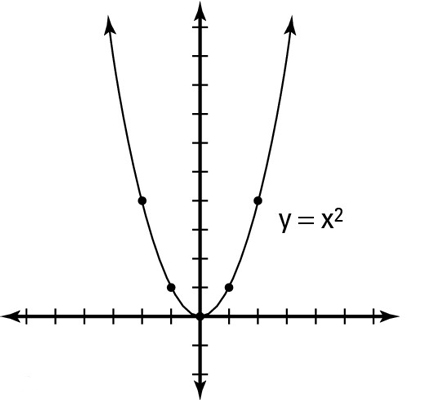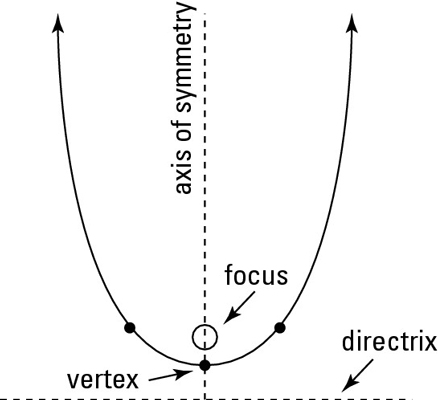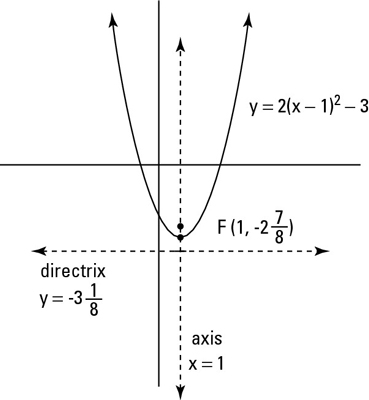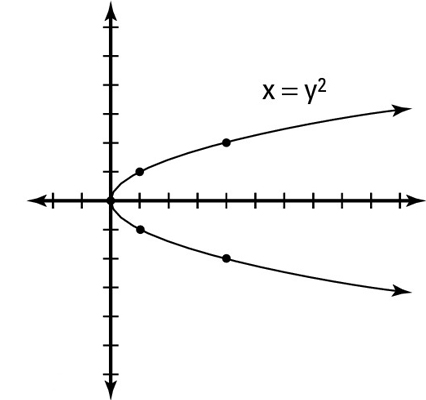In order to graph a parabola correctly, it is important to note whether it is a horizontal or a vertical parabola. This is because while the variables and constants in the equations for both curves serve the same purpose, their effect on the graphs in the end is slightly different.
Graph a vertical parabola
A vertical parabola has its axis of symmetry at x = h, and the vertex is (h, v). With this information, you can find the following parts of the parabola:
Focus: The distance from the vertex to the focus is 1/(4a), where a can be found in the equation of the parabola (it is the scalar in front of the parentheses). The focus, as a point, is (h, v + 1/(4a)); it should be directly above or directly below the vertex. It always appears inside the parabola.
Directrix: The equation of the directrix is y = v – 1/(4a). It should be the same distance from the vertex along the axis of symmetry as the focus, in the opposite direction.
The directrix appears outside the parabola and is perpendicular to the axis of symmetry. Because the axis of symmetry is vertical, the directrix is a horizontal line; thus, it has an equation of the form y = a constant, which is v – 1/(4a).
The squaring of the variables in the equation of the parabola determines where it opens: When the x is squared and y is not, the axis of symmetry is vertical and the parabola opens up or down. For instance,
is a vertical parabola; its graph is shown below.

Be aware of negative coefficients in parabolas. If the parabola is vertical, a negative coefficient will make the parabola open downward.

The above figure can be referred to as the “martini” of parabolas. The graph looks like a martini glass: The axis of symmetry is the glass stem, the directrix is the base of the glass, and the focus is the olive. You need all those parts to make a good martini and a parabola.
For example, the equation
has its vertex at (1, –3). This means that a = 2, h = 1, and v = –3. With this information, you can identify all the parts of a parabola (axis of symmetry, focus, and directrix) as points or equations:
Find the axis of symmetry.
The axis of symmetry is at x = h, which means that x = 1.
Determine the focal distance and write the focus as a point.
You can find the focal distance by using the formula 1/(4a). Because a = 2, the focal distance for this parabola is 1/8. With this distance, you can write the focus as the point

Find the directrix.
You can use the equation of the directrix:

Graph the parabola and label all its parts.

You can see the graph, with all its parts, in the above figure. It is always a good idea to plot at least two other points besides the vertex so that you can show that your vertical transformation is correct. Because the vertical transformation in this equation is a factor of 2, the two points on both sides of the vertex will be stretched by a factor of two. So, from the vertex, you plot a point that is to the right one, and up two (instead of up one). Then you can draw the same point on the other side of the axis of symmetry; the two other points on the graph are at (2, –1) and (0, –1).
Graph a horizontal parabola
A horizontal parabola features its own equations to find its parts; these are just a bit different when compared to a vertical parabola. The distance to the focus and directrix from the vertex in this case is horizontal, because they move along the axis of symmetry, which is a horizontal line. So, 1/(4a) is added to and subtracted from h. Here’s the breakdown:
The axis of symmetry is at y = v, and the vertex is still at (h, v).
The focus is directly to the left or right of the vertex, at the point

The directrix is the same distance from the vertex as the focus in the opposite direction, at

For example, work with the equation
Find the axis of symmetry.
The vertex of this parabola is (3, 1). The axis of symmetry is at y = v, so for this example, it is at y = 1.
Determine the focal distance and write this as a point.
For the equation above, a = 1/8, and so the focal distance is 2. Add this value to h to find the focus: (3 + 2, 1) or (5, 1).
Find the directrix.
Subtract the focal distance from Step 2 from h to find the equation of the directrix. Because this is a horizontal parabola and the axis of symmetry is horizontal, the directrix will be vertical. The equation of the directrix is x = 3 – 2 or x = 1.
Graph the parabola and label its parts.

The above figure shows you the graph and has all of the parts plotted for you.
The focus lies inside the parabola, and the directrix is a vertical line 2 units from the vertex.
The squaring of the variables in the equation of the parabola determines where it opens: When y is squared and x is not, the axis of symmetry is horizontal and the parabola opens left or right. For example,

Be aware of negative coefficients in parabolas. If the parabola is horizontal, a negative coefficient will make the parabola open to the left.
dummies
Source:http://www.dummies.com/how-to/content/how-to-graph-a-parabola.html
No comments:
Post a Comment